Lateral mass may refer to:
| This disambiguation page lists articles associated with the title Lateral mass. If an internal link led you here, you may wish to change the link to point directly to the intended article. |
Lateral mass may refer to:
| This disambiguation page lists articles associated with the title Lateral mass. If an internal link led you here, you may wish to change the link to point directly to the intended article. |

In anatomy, the atlas (C1) is the most superior (first) cervical vertebra of the spine.

The Millennium Bridge, officially known as the London Millennium Footbridge, is a steel suspension bridge for pedestrians crossing the River Thames in London, linking Bankside with the City of London. It is located between Southwark Bridge and Blackfriars Railway Bridge. It is owned and maintained by Bridge House Estates, a charitable trust overseen by the City of London Corporation. Construction began in 1998, and it initially opened in June 2000.

The clavicle or collarbone is a long bone that serves as a strut between the shoulder blade and the sternum or breastbone. There are two clavicles, one on the left and one on the right. The clavicle is the only long bone in the body that lies horizontally. Together with the shoulder blade it makes up the shoulder girdle. It is a touchable bone and in people who have less fat in this region, the location of the bone is clearly visible, as it creates a bulge in the skin. It receives its name from the Latin: clavicula because the bone rotates along its axis like a key when the shoulder is abducted. The clavicle is the most commonly fractured bone. It can easily be fractured due to impacts to the shoulder from the force of falling on outstretched arms or by a direct hit.

The brainstem is the posterior part of the brain, continuous with the spinal cord. In the human brain the brainstem includes the midbrain, and the pons and medulla oblongata of the hindbrain. Sometimes the diencephalon, the caudal part of the forebrain, is included.

The flying buttress is a specific form of buttress composed of an arch that extends from the upper portion of a wall to a pier of great mass, in order to convey to the ground the lateral forces that push a wall outwards, which are forces that arise from vaulted ceilings of stone and from wind-loading on roofs.

Retaining walls are relatively rigid walls used for supporting the soil mass laterally so that the soil can be retained at different levels on the two sides. Retaining walls are structures designed to restrain soil to a slope that it would not naturally keep to. They are used to bound soils between two different elevations often in areas of terrain possessing undesirable slopes or in areas where the landscape needs to be shaped severely and engineered for more specific purposes like hillside farming or roadway overpasses. A retaining wall that retains soil on the backside and water on the frontside is called a seawall or a bulkhead.

A centreboard or centerboard (US) is a retractable keel which pivots out of a slot in the hull of a sailboat, known as a centreboard trunk (UK) or centerboard case (US). The retractability allows the centreboard to be raised to operate in shallow waters, to move the centre of lateral resistance, to reduce drag when the full area of the centreboard is not needed, or when removing the boat from the water, as when trailering. A centreboard which consists of just a pivoting metal plate is called a centerplate. A daggerboard is similar but slides vertically rather than pivoting.

The deltoid muscle is the muscle forming the rounded contour of the human shoulder. It is also known as the 'common shoulder muscle', particularly in other animals such as the domestic cat. Anatomically, it appears to be made up of three distinct sets of fibers though electromyography suggests that it consists of at least seven groups that can be independently coordinated by the nervous system.
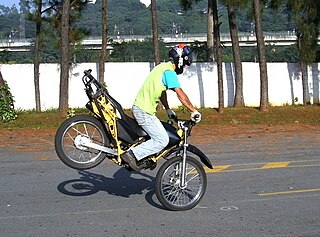
Weight transfer and load transfer are two expressions used somewhat confusingly to describe two distinct effects: the change in load borne by different wheels of even perfectly rigid vehicles during acceleration, and the change in center of mass (CoM) location relative to the wheels because of suspension compliance or cargo shifting or sloshing. In the automobile industry, weight transfer customarily refers to the change in load borne by different wheels during acceleration. This is more properly referred to as load transfer, and that is the expression used in the motorcycle industry, while weight transfer on motorcycles, to a lesser extent on automobiles, and cargo movement on either is due to a change in the CoM location relative to the wheels. This article uses this latter pair of definitions.
The roll center of a vehicle is the notional point at which the cornering forces in the suspension are reacted to the vehicle body.

In the brain, the interventricular foramina are channels that connect the paired lateral ventricles with the third ventricle at the midline of the brain. As channels, they allow cerebrospinal fluid (CSF) produced in the lateral ventricles to reach the third ventricle and then the rest of the brain's ventricular system. The walls of the interventricular foramina also contain choroid plexus, a specialized CSF-producing structure, that is continuous with that of the lateral and third ventricles above and below it.
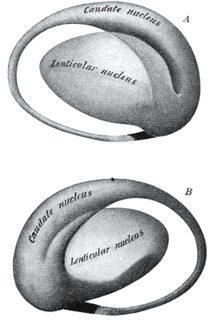
The lentiform nucleus or lenticular nucleus comprises the putamen and the globus pallidus within the basal ganglia. With the caudate nucleus it forms the striatum. It is a large, lens-shaped mass of gray matter just lateral to the internal capsule.
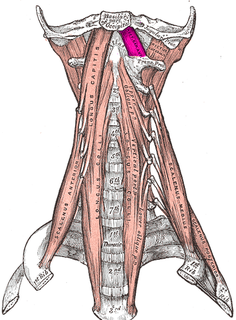
The rectus capitis anterior is a short, flat muscle, situated immediately behind the upper part of the Longus capitis.

The Adductor hallucis arises by two heads—oblique and transverse and is responsible for adducting the big toe. It has two heads, both are innervated by the lateral plantar nerve.

The gluteal muscles are a group of three muscles which make up the buttocks: the gluteus maximus, gluteus medius and gluteus minimus. The three muscles originate from the ilium and sacrum and insert on the femur. The functions of the muscles include extension, abduction, external rotation and internal rotation of the hip joint.

The erector spinae or spinal erectors is a set of muscles that straighten and rotate the back.
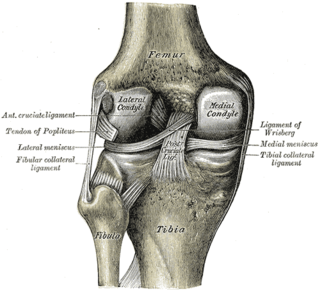
The medial condyle is one of the two projections on the lower extremity of femur, the other being the lateral condyle.
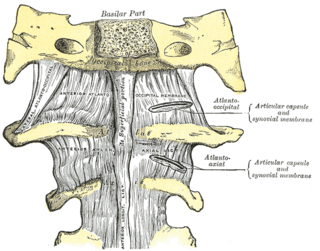
The atlantoaxial joint is a joint in the upper part of the neck between the first and second cervical vertebrae; the atlas and axis. It is a pivot joint.
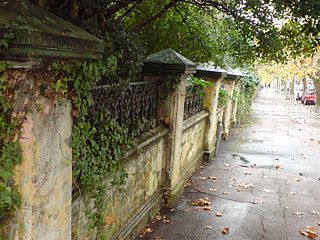
Lateral earth pressure is the pressure that soil exerts in the horizontal direction. The lateral earth pressure is important because it affects the consolidation behavior and strength of the soil and because it is considered in the design of geotechnical engineering structures such as retaining walls, basements, tunnels, deep foundations and braced excavations.

A Cable fly or Cable flye is a strength training exercise in which the hand and arm move through an arc while the elbow is kept at a constant angle. Flies are used to work the muscles of the upper body. Because these exercises use the arms as levers at their longest possible length, the amount of weight that can be moved is significantly less than equivalent press exercises for the same muscles . Due to this leverage, fly exercises of all types have a large potential to damage the shoulder joint and its associated ligaments and the tendons of the muscles connecting to it. They should be done with caution and their effects first tested while using very light weights; which are gradually incremented after more strength is gained.